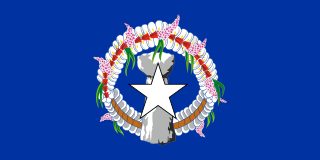
Guam is an unincorporated and organized territory of the United States in Micronesia in the western Pacific Ocean. It is the westernmost point and territory of the United States, along with the Northern Mariana Islands. The capital city of Guam is Hagåtña and the most populous city is Dededo. The inhabitants of Guam are called Guamanians, and they are American citizens by birth. Indigenous Guamanians are the Chamorros, who are related to other Austronesian natives of Eastern Indonesia, the Philippines, and Taiwan. Guam has been a member of the Pacific Community since 1983.
The history of Guam involves phases including the early arrival of Austronesian people known today as the Chamorros around 2000 BC, the development of "pre-contact" society, Spanish colonization in the 17th century and the present American rule of the island since the 1898 Spanish–American War. Guam's history of colonialism is the longest among the Pacific islands.

The Northern Mariana Islands, officially the Commonwealth of the Northern Mariana Islands, is an insular area and commonwealth of the United States consisting of 14 islands in the northwestern Pacific Ocean. The CNMI includes the 14 northernmost islands in the Mariana Archipelago except the southernmost island of the chain, Guam, which is a separate U.S. territory. The CNMI and Guam are the westernmost point and territory of the United States.

Violeta Chamorro is a Nicaraguan politician, former president and publisher, known for ending the Contra War, the final chapter of the Nicaraguan Revolution, and bringing peace to the country. She was the first and, to date, only woman to hold the position of president in Nicaragua.

Chamorro is an Austronesian language spoken by about 58,000 people. It is the native and spoken language of the Chamorro people who are the indigenous people of Guam and the Northern Mariana Islands, both US territories.

The Chamorro people (/tʃɑˈmɔroʊ/) are the indigenous people of the Mariana Islands; politically divided between the United States territory of Guam and the Commonwealth of the Northern Mariana Islands in Micronesia. Today, significant Chamorro populations also exist in several U.S. states including Hawaii, California, Washington, Texas, Tennessee, Oregon, and Nevada. According to the 2000 Census, approximately 65,000 people of Chamorro ancestry live in Guam and another 19,000 live in the Northern Marianas. Another 93,000 live outside the Marianas in Hawaii and the West Coast of the United States. The Chamorros are primarily Austronesian, but many also have European (Spanish) and East Asian ancestry.
Pedro Joaquín Chamorro Cardenal was a Nicaraguan journalist and publisher. He was the editor of La Prensa, the only significant opposition newspaper to the long rule of the Somoza family. He is a 1977 laureate of the Maria Moors Cabot Prize of the University of Columbia. He married Violeta Barrios de Chamorro who later went on to become President of Nicaragua (1990-1996). In 1978, he was shot to death, one of the precipitating events of the overthrow of the Somoza regime the following year.
The music of Guam encompasses the works of many Chamorro popular musicians, including KACY, Flora Baza Quan, Daniel De Leon Guerrero, singer-songwriter J. D. Crutch, who is on the local Napu Records and who released a best-selling local album with Guinaifen Manglo. The state song of Guam is "Guam Hymn" by Ramon Sablan, adopted in 1919. Flora Baza Quan is especially notable throughout the territory, and is known as the "Queen of Chamorro Music".
The music of the Northern Mariana Islands is dominated by the folk music of the Chamorros, which remains an important part of the islands' culture, though elements of music left by American, German, Spanish and Japanese colonizers are also in evidence. There are both Carolinian and Chamorro traditional chant styles. A variant of the Spanish cha-cha-chá is popular, as is a Carolinian "stick dance" which combines improvised percussion and foot stomping. A well-known stick dance group is the Talabwog Men Stick Dancers.

Emiliano Chamorro Vargas was the President of Nicaragua from 1 January 1917 to 1 January 1921 and again from 14 March 1926 to 11 November 1926.
La Prensa is a Nicaraguan newspaper, with offices in the capital Managua. Its current daily circulation is placed at 42,000.
Pedro Joaquín Chamorro Alfaro was the President of Nicaragua from 1 March 1875 to 1 March 1879 and a member of the conservative dominant oligarchy Chamorro family.

Diego Manuel Chamorro Bolaños was the President of Nicaragua between 1 January 1921 and 12 October 1923. He belonged to the Conservative Party of Nicaragua.

Diego Luis de San Vitores was a Spanish Jesuit missionary who founded the first Catholic church on the island of Guam. He is responsible for establishing the Christian presence in the Mariana Islands. He is a controversial figure to some today due to his conflict with the indigenous Chamorro leader Mata'pang.
Rosendo Chamorro Oreamuno was briefly President of Nicaragua in 1923. He received a doctorate from the University of Paris.

The Chamorro Time Zone, formerly the Guam Time Zone, is a United States time zone which observes standard time ten hours ahead of Coordinated Universal Time (UTC+10:00). The clock time in this zone is based on the mean solar time of the 150th meridian east of the Greenwich Observatory.
The media of Nicaragua consist of several different types of communications media: television, radio, cinema, newspapers, magazines, and Internet-based Web sites.

Salvador Pérez Martínez, known as Salva Chamorro, is a spanish professional footballer who sign in as a striker for the Indian club Mohun Bagan A.C.

Sybra is a genus of beetles in the family Cerambycidae, containing the following species:











